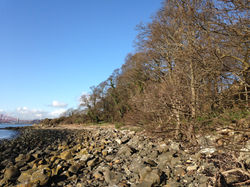September: Changing Seasons
This is a time of transition, we still have warm weather but daylength changes are now at their most rapid and days are becoming noticeably shorter. Some of the sounds of summer are however still to be heard as you walk the coastal path; Common Terns, that breed nearby, still patrol out in the Forth, calling constantly as they wheel, hover and then dive for fish, stocking up for their imminent departure to the warmer climes of Africa.

Swallows too can be seen flying along the woodland edges on a warm still day, making the most of the myriad small insects emerging from the trees to top up their fat reserves as they continue their migration south. Not all summer birdsong has ceased however, a walk in the woodlands at this time is accompanied by the somewhat tentative songs of the robins, usually from deep in the undergrowth, as they seek to establish and declare winter territories. These can be a key part of obtaining food for the winter as well as setting up good breeding territories for next spring. Thanks to them there is birdsong to remind you of warmer days right through the winter.
Trees too are winding down, leaves begin to look tired and the colour changes associated with autumn are already evident, though this year some of this is associated with the very dry late summer conditions and drought stress. Already there is a steady slow rain of dry and curled leaves onto the pathways.

This Oak on the seaward edge of Bathing House Wood also shows some wind damage and beneath one leaf are the Spangle Galls produced by a tiny wasp that induces the tree to produce the gall which is both a source of food and protection for the single larva contained within each spangle.

As they mature the galls will fall off and protect the wasp pupa over the winter ready for the tiny adult to emerge in the spring. Where part of the leaf dies before the galls are mature, as in the one shown, so too do the galls and the wasp larvae they contain. The two towards the tip of the leaf, which appear rather brown and shrivelled, have suffered this fate.
But the end of summer is not just a time of shutting down; it is a vital time for seed dispersal. Berries on Hawthorn and Rowan are red and ripe to entice the birds that will eat them and spread their seeds.


Rowan berries are more sought-after than Hawthorn and many have already been devoured by hungry Blackbirds that are finding it difficult to locate any worms in the ground, dried hard by the lack of rain. Blackbirds often take over and protect a good berry rich tree, but they cannot withstand the depredations of the large flocks of Redwings and Fieldfares that come over from Scandinavia for the winter and rapidly strip any berries that are still on the trees. You will know they have arrived when Rowans are suddenly bare of berries.
In the wildflower area the seed heads may not be as bright as the shiny berries and look much less attractive than the flowers that preceded them and delighted passers by this summer, but they are of course the key to further blooms next year. Most of the seed will fall beneath the existing plants and will germinate to produce flowers again next year; but we want to spread the summer display of colour over a wider area, so some of the seed is being collected as it ripens. Here Erinn, Amy and Katrina are collecting Poppy seed heads. You can tell when they are ripe as the pores round the rim open, and then the seed is ready to fall; collecting these produces an abundance of seed for next year.


As flowering is tailing off, so most Bumblebee colonies have also completed their cycles and the new queens are dispersing. The very large and unmistakeable queens of Buff-tailed can be seen in gardens at this time, topping up on any nectar rich flowers they can find in order to store enough fat for their winter hibernation. Only Common Carders seem still to be actively feeding developing brood in their summer nests. For them, the reduction in grasses on the bank beside Crow Wood, part of the wildflower planting area, has provided a late bonus with a widespread growth of White Dead-nettle, a species that they can access with their longer tongues, and there are pristine newly emerged queens making good use of it. If you stand and watch for a moment or two you will see the gingery Common Carder Bumblebee queens going from flower to flower.

Not all flowering ceases with the onset of autumn. Where Ivy is well established and high up on a tree or a wall, and especially if it faces south, it will produce flowers that will begin to open towards the end of September and go on flowering until November. These are a vital nectar source for late flying insects and some butterflies that may temporarily emerge from hibernation on a warm day. Much of the Ivy around our woodlands is showing the clusters of tight green buds as in the photo on the right.
The signs of summer’s end can be a little disheartening as they suggest that the cold dark days of winter may not be too far away, but in reality the cycle of life is merely slowing down and changing phase; and it is already gearing up for next year’s exuberance of production.
Dick Alderson
13 September 2014







































